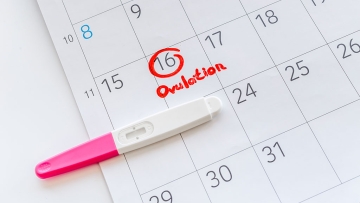If you and your partner are trying to conceive, it can be incredibly helpful to determine when you are most fertile. To determine this, you will need to track your ovulation. Females are most fertile within a day or two of ovulation. During ovulation, an egg is released from the ovaries. The egg, once released, has just 12-24 hours to be fertilized.
What You Need To Know About Ovulation
A woman’s menstruation cycle consists of 28 days. The ovulation process typically starts after 14 days from the start of her periods. However, some women have variations in their cycles ranging between 23 and 35 days. This is important to know, especially for couples planning for a child together.
Though eggs do not have more than 24 hours for fertilization post-ovulation, sperm can stay in the fallopian tubes for nearly five days. This lends a limited fertile window of not more than a week every month for couples to conceive.
To increase your chances of conceiving, it’s essential to recognize the signs of ovulation. Knowing this information can help you identify the possible dates to have sex for a successful conception.
Women can make the most of their knowledge about ovulation to plan their pregnancies by regularly recording details of their menstrual cycles. Patience is the key to tracking the cycles every month, noting the irregularities and jotting down the ovulation symptoms.
Knowing the signs of ovulation and timing your sexual activity accordingly does not ensure conception and pregnancy 100 percent of the time. Research studies highlight that the possibility of conceiving despite having sex within the fertile window is just 20 percent. Therefore, couples planning to become pregnant should understand that it may take several months to conceive. If you have been trying to conceive for six months or more unsuccessfully, it’s time to talk with a fertility specialist.
Signs of ovulation
Many women are not sure how to tell whether they are ovulating or not. This is because they are not aware of the signs of ovulation. They don’t know what it feels like when their ovaries release the eggs for fertilization. Some of the common symptoms of ovulation day include:
- Changes in body temperature. The basal temperature, or the temperature when the body is resting, will fall slightly before rising again. To identify the fall and subsequent rise in temperature, women can check their body temperature every morning before getting out of bed. Women are most fertile two or three days before the temperature rises, which means they are more likely to conceive.
- Differences in vaginal discharge. The cervical mucus, a slippery fluid coming out of the vagina, is clearer and thinner like egg whites.
Breast tenderness. Women tend to develop tender breasts during this period apart from suffering from cramps and feeling bloated. The symptoms above are expected during the ovulation period. However, they do not always mean that a woman is ovulating.
Related:Ovulation Problem and Infertility
Tracking ovulation symptoms
Keeping a mental or physical note of the signs of ovulation is not difficult. Here are some simple ways to keep track:
- Mark your calendar: It is common to note down the date on which the menstrual cycle begins. However, not many take note of how long it lasts. Fertility experts advise couples to have sex at least every other day, especially five days before the woman ovulates.
- Body temperature rise: Many women experience hormonal changes during the menstrual cycle. The ovaries release an egg on the release of increased levels of the estrogen hormone. The body then starts to make another hormone called progesterone. The release of these hormones increases the body temperature slightly.
- Mucus discharge: The hormones cause the cervix mucus to get more clear and slippery. Resembling egg whites, this feature of the mucus helps sperm travel in the body. Women must know on the formation of this mucus that their bodies are fertile and ready to conceive.
- Ovulation predictor kits: Women not sure of their ovulation cycle can opt for these kits that inform them of when to expect their fertile window. The kits test their urine to evaluate the luteinizing hormone (LH) levels that go up 24-36 hours before ovulating. Women can check multiple times to determine the next date on which they ovulate by using the multiple test strips available with the kits.
- Progesterone ovulation tests: With these tests, women can assess the levels of progesterone metabolite (pregnanediol glucuronide, or PdG) in their urine to check if they have ovulated. Women can rely on the effectiveness of these tests since the levels of PdG rise post ovulation.
- Cramping or pain: A slight pain on the waist side halfway through the cycle is often misinterpreted as a sign of ovulation by many women. However, this feeling of uneasiness means that the fertile window is closing.
When to Consult a Fertility Specialist?
Some women have a predictable 28-day menstrual cycle. This makes it easier to track the fertility window. Other women don’t have a predictable cycle, which can cause fertility problems. If this is the case, and you have tried unsuccessfully for more than six months to conceive, then you should consult a fertility doctor.
At ART Fertility Clinics, our team of specialized Infertility Specialists considers the symptoms of the ovulation period to check the patients’ ovulation cycle. Also, there may be many factors impeding the pregnancy of many women. Therefore, we understand that the ovulation cycle may be affected for many reasons. With state-of-the-art technology, we help couples realize their dream of becoming parents once, twice, or as many times they want.



